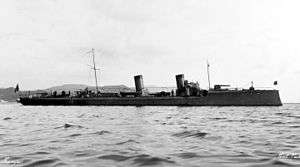Lampo-class destroyer
The Lampo class was a class of six destroyers of the Italian Regia Marina (Royal Navy) built by the German Schichau shipyard from 1899–1901. They served in the Italo-Turkish War (where one was lost) and the surviving ships in the First World War, before being disposed of between 1920 and 1924.
 Lampo circa 1900, just after delivery | |
| Class overview | |
|---|---|
| Name: | Lampo class |
| Builders: | Schichau-Werke, Elbing |
| Operators: |
|
| Preceded by: | Fulmine |
| Succeeded by: | Nembo class |
| Built: | 1899–1902 |
| In commission: | 1900–1924 |
| Completed: | 6 |
| Lost: | 1 |
| Scrapped: | 5 |
| General characteristics | |
| Type: | Destroyer |
| Displacement: |
|
| Length: | |
| Beam: | 6.50 m (21 ft 4 in) |
| Draught: | 2.60 m (8 ft 6 in) |
| Propulsion: |
|
| Speed: | 31 knots (57 km/h; 36 mph) |
| Range: |
|
| Complement: | 59 |
| Armament: |
|
Design
In 1899,[1] the Italian Navy ordered six destroyers from the German shipyard Schichau-Werke of Elbing, Prussia (now Elbląg in Poland). The design was typical for Schichau-designed destroyers of the period, with a raised turtleback[lower-alpha 1] forecastle, a ram bow and two funnels.[3]
The ships were 60.00 metres (196 ft 10 in) long between perpendiculars and 62.05 metres (203 ft 7 in) overall, with a beam of 6.50 metres (21 ft 4 in) and a draught of 2.60 metres (8 ft 6 in).[4] Displacement was 315 long tons (320 t) normal and 348 long tons (354 t) full load.[1][4] They were powered by two triple expansion steam engines fed by four Thornycroft water-tube boilers which were rated at 6,000 ihp (4,500 kW) driving two shafts to give a design speed of 30 knots (56 km/h; 35 mph).[4][5] Sufficient coal was carried to give an endurance of 2,000 nautical miles (3,700 km; 2,300 mi) at 12 knots (22 km/h; 14 mph) or 290 nautical miles (540 km; 330 mi) at 26 knots (48 km/h; 30 mph).[1][4]
Gun armament varied between ships. Lampo, Freccia, Dardo and Euro carried a single 76 mm (3 in)/40 calibre gun (capable of firing a 5.9 kilograms (13 lb) shell to a range of 9,850 metres (32,320 ft) at a rate of fire of 15 rounds per minute per gun[6]) and five 57 mm/43 guns, while Strale and Ostro carried six 57 mm guns. Torpedo armament consisted of two 356 mm (14 in) torpedo tubes.[4] The ships' crew consisted of 59 officers and men.[1]
The six ships were laid down between 1899 and 1900 and completed between 1900 and 1902.[5] While the ships were fast, reaching speeds of over 31 knots (57 km/h; 36 mph) during sea trials (corresponding to a realistic sea speed of 25 knots (46 km/h; 29 mph)),[5] seaworthiness was poor.[3][4][7]
Service
The ships of the class were active during the Italo-Turkish War of 1911–1912. One ship, Freccia ran aground in a storm off Tripoli, Libya, on 12 October 1911,[5][8] a few days after the city was captured by the Italians.[9] Other ships in the class took part in operations along the coast of Libya,[10] and in the Dodecanese.[11]
In 1914, the remaining ships of the class formed part of the 6th Destroyer Division, based in Libya.[3] During the First World War, the ships of the class were modified for minelaying, being fitted to carry at least 12 mines.[4] The ships were used as escorts in North African waters and in the Tyrrhenian Sea,[3][12] and as such carried depth charges and anti-submarine sweeps.[1]
The ships of the class were disposed on during the early 1920s, with the last one stricken in November 1924.[5]
Ships
| Ship | Laid down[5] | Launched[5] | Completed[5] | Operational History |
|---|---|---|---|---|
| Lampo | 6 May 1899 | 7 October 1899 | 23 June 1900 | Disposed of 18 March 1920[4] |
| Freccia | 1899 | 23 November 1899 | 25 May 1902 | Ran aground off Tripoli, 12 October 1911[4][5] |
| Dardo | 17 August 1899 | 7 February 1900 | 16 March 1901 | Disposed of 18 March 1920[4] |
| Strale | 7 November 1899 | 19 May 1900 | 6 July 1901 | Disposed of 13 January 1924[5] |
| Euro | 9 January 1900 | 27 August 1900 | 11 October 1901 | Reclassified as torpedo-boat 17 January 1921. Used as target ship 1923–24 Renamed Strale 9 September 1924 Disposed of 13 November 1924[4][5] |
| Ostro | 23 March 1900 | 9 February 1901 | 8 December 1901 | Disposed of 30 September 1920[4] |
Notes
- A turtleback is an arched structure over the deck of a ship, normally at the ship's bow.[2]
Citations
- "Lampo: Cacciatorpediniere" (in Italian). Marina Militare. Retrieved 2 January 2015.
- "turtleback: Definitions". wordnik.com. Retrieved 2 January 2015.
- Purnell's Illustrated Encyclopedia of Modern Weapons and Warfare, p. 1616.
- Chesneau and Kolesnik 1979, p. 355.
- Fraccaroli 1970, p55.
- Fraccaroli 1970, pp. 281–282.
- Fraccaroli 1970, p. 56.
- "Il cacciatorpediniere "Freccia" riprendera presto il mare". La Stampa (in Italian). 16 October 1911. p. 2. Retrieved 3 January 2015.
- Beehler 1913, pp. 20–21.
- Beehler 1913, pp. 35, 47.
- Beehler 1913, pp. 69, 74.
- Fraccaroli 1970, pp. 59, 265–266, 268–269, 272.
References
- Beehler, William Henry (1913). The History of the Italian-Turkish War, Sept. 29, 1911 to Oct. 18, 1912. Annapolis, Maryland, USA: Advertiser-Republican.
- Chesneau, Roger; Kolesnik, Eugene M (1979). Conway's All The World's Fighting Ships 1860–1905. London: Conway Maritime Press. ISBN 0-85177-133-5.
- Fraccaroli, Aldo (1970). Italian Warships of World War 1. London: Ian Allan. ISBN 0-7110-0105-7.
- "Lampo". Purnell's Illustrated Encyclopedia of Modern Weapons and Warfare. London: Phoebus Pub. Co.: 1616 1978–1979.